Launching an online store is the easy part. The real headache comes when you're trying to decide where to build it, and that's exactly the crossroads many merchants find themselves at when weighing Volusion vs WooCommerce!
To cut through the noise, we've broken down Volusion and WooCommerce across the criteria that matter most:
- Ease of use
- Hosting requirements
- Customization
- Inventory management
- Payment processing
- Shipping
- Extensions & plugins
- Scalability
- SEO & marketing tools
- Customer support
- Security
- Pricing
Let's get started!
Volusion vs WooCommerce: A Quick Overview
Volusion pros & cons
Volusion has been around since 1999 and was one of the early SaaS players in the eCommerce space. Though it no longer commands the same market share as Shopify or WooCommerce, Volusion still supports roughly 5,000 online stores as of 2025 (mainly concentrated in the U.S) and remains quite popular due to its all-in-one hosted approach.
Volusion Pros | Volusion Cons |
Fully hosted, no need to manage servers or hosting | Limited customization (no server-level access) |
Built-in security and compliance handled for you | Fewer themes and extensions compared to WooCommerce |
Native shipping tools are more comprehensive than WooCommerce’s defaults | International payment support is limited (Volusion Payments only U.S.) |
Direct customer support via chat, email, and phone (higher tiers) | No native blogging feature, which limits SEO |
Predictable pricing with bundled hosting and SSL | Scalability capped by its hosted environment |
WooCommerce pros & cons
Meanwhile, WooCommerce is the world’s most widely used eCommerce solution, powering over 6.1 million websites globally.
As a plugin for WordPress, it taps into an ecosystem that dominates 40%+ of the web and gives merchants access to virtually unlimited customization and extensions. Its open-source nature makes it the go-to choice for businesses that want flexibility and long-term scalability.
WooCommerce Pros | WooCommerce Cons |
Completely free to install as a WordPress plugin | Requires hosting setup and ongoing maintenance |
Massive ecosystem (1,100+ WooCommerce extensions + 60,000+ WordPress plugins) | Costs can escalate quickly once you add hosting, themes, and premium plugins |
Full customization via themes, hooks, filters, and template overrides | Security responsibility rests heavily on the merchant |
WooPayments and 80+ gateways for global flexibility | Learning curve can be steeper for beginners with no WordPress experience |
Scalability is virtually unlimited with the right hosting setup | Reliance on third-party extensions can create compatibility issues |
Volusion vs WooCommerce: Which Is Better?
Looking at every factor side by side, the overall winner in 2025 is WooCommerce. It consistently proves to be more adaptable, scalable, and supported by a thriving ecosystem.
That being said, Volusion is far from irrelevant. Its hosted approach makes it attractive to small and mid-sized businesses that want simplicity and predictable pricing without juggling multiple plugins or hosting providers. You can see a quick summary of the WooCommerce vs Volusion comparison below:
Criterion | Volusion | WooCommerce | Winner |
Ease of Use | Simple wizard setup, hosted | Easy via WordPress integration | Tie |
Hosting Requirements | Fully hosted, hands-off | Merchant-managed | Volusion |
Customization | Limited to HTML/CSS/JS | Open-source, near-unlimited | WooCommerce |
Inventory Management | Basic tools, multi-location on higher plans | Broader product types, scalable via extensions | WooCommerce |
Payment Processing | 30+ gateways, Volusion Payments (U.S. only) | 80+ gateways, WooPayments in 35+ countries | WooCommerce |
Shipping | 6 categories, comprehensive native options | Basic defaults, relies on extensions | Volusion |
Extensions & Plugins | 80+ marketplace solutions | 1,100+ WooCommerce extensions + WordPress library | WooCommerce |
Scalability | Reliable but capped | Unlimited with proper hosting | WooCommerce |
SEO & Marketing Tools | Basic SEO + promotions | 200+ marketing extensions + SEO plugins | WooCommerce |
Customer Support | Direct chat, email, and phone | Self-service docs + community | Volusion |
Security | PCI DSS Level 1, SSL included | Frequent updates but higher user responsibility | Volusion |
Pricing | 4 transparent plans | Free core, but costly once extended | Volusion |
Like to dig deeper? Keep reading our detailed breakdown below.
Ease of Use (A tie)
The Verdict: Volusion vs WooCommerce are built on different foundations (one as a hosted solution and the other as an open-source plugin). Nevertheless, both manage to deliver an experience that's approachable and practical for merchants.
In the end, both the Volusion vs WooCommerce approaches lead to a smooth onboarding process and an easy-to-manage store. Here's how that plays out in practice:
Volusion's ease of use
Like most hosted platforms, Volusion's strength lies in its simple setup process.
Indeed, once you sign up, you're immediately given access to a 14-day free trial without having to enter payment information. Better yet, from the very beginning, a step-by-step wizard will walk you through the fundamentals of building your store. You'll be prompted to choose a template, upload your logo, and add your first products, which creates a sense of progress and helps new merchants get comfortable quickly.

The dashboard you land on after setup is equally straightforward. Navigation is organized into logical sections, so no matter which section you want to focus on, everything is exactly where you expect it to be. Even first-time store owners should find it easy to approach without unnecessary clutter.
WooCommerce's ease of use
WooCommerce, though open-source, takes advantage of the familiar WordPress environment to keep things simple. Instead of a complicated installation, all you need to do is search for WooCommerce in the WordPress plugin library, click “Install Now,” and activate it!

From there, the plugin integrates seamlessly into your existing WordPress dashboard. Basically, if you already know how to navigate WordPress, you'll feel right at home – and even complete beginners usually find the interface intuitive. The dashboard also keeps everything neatly arranged, from managing inventory and processing orders to configuring payment and shipping settings.
Hosting Requirements (Volusion wins)
The Verdict: Since it is a fully hosted platform, Volusion automatically provides and manages the server environment, so you don’t have to think about hosting at all. As a result, merchants can start setting up their store right away without worrying about technical requirements.
That said, the story might also change depending on what you value more: convenience with fewer decisions, or flexibility with more responsibility. Let’s look at how Volusion vs WooCommerce differ in practice.
Volusion’s hosting requirements
With Volusion, everything related to hosting is already taken care of, as the platform itself manages the servers, infrastructure, and back-end technical details.
Hence, you don’t need to shop for a separate hosting provider, configure PHP versions, or set up additional security layers to keep your site running smoothly! You only need to maintain your focus on what really matters, such as designing your storefront and managing sales. Needless to say, such a level of convenience is a huge draw for merchants who don’t want to deal with the technical side of eCommerce.
Nevertheless, keep in mind that it does come with trade-offs. Since Volusion is hosted, you have to give up some control over performance tuning, server-level customization, and scaling options. You also need to operate within the boundaries of Volusion’s plans, which inevitably include caps on resources or features.
WooCommerce’s hosting requirements
WooCommerce, on the other hand, shifts the responsibility onto the merchant.
Since it runs on WordPress, the entire store resides on whichever server you choose for your WordPress site, meaning this design gives you complete control over performance and scaling. Or, if you want to fine-tune caching, set up a content delivery network, or optimize your database for speed, you have the freedom to do so!
The flip side, obviously, is that this control requires effort. You’re the one who must ensure that your hosting environment is up to standard, with the right versions of PHP and MySQL, sufficient memory limits, and SSL configured for security. Many merchants choose to rely on managed WooCommerce hosting providers to reduce such burden, but the responsibility still lies with you to select the appropriate setup.
Customization (WooCommerce wins)
The Verdict: WooCommerce's open-source foundation gives merchants far more freedom to modify, extend, and personalize their stores compared to Volusion's more locked-down, hosted setup.
Sure, Volusion does provide customization tools, but the depth and flexibility of WooCommerce simply go much further. You can see the stark difference between Volusion vs WooCommerce in the breakdown below:
Volusion's customization
At the moment, Volusion offers 24 pre-built themes and around 40 eCommerce-specific templates in total, which is admittedly a much smaller library compared to many of its competitors. All these themes can be personalized with Volusion's built-in editor, meaning you can adjust fonts, colors, and block placements without touching code.

For those who want more control, the File Editor in the admin area allows editing with HTML and CSS, and JavaScript can be added to introduce interactive elements or small functional tweaks. However, keep in mind that Volusion places limits on how and where scripts can be used to preserve platform security and PCI compliance.
And remember: Since Volusion is a fully hosted SaaS solution, you will never gain server-level access. Simply put, unlike with WooCommerce, there's no way to install custom PHP scripts, nor can you change the underlying backend logic. In practice, you're confined to front-end code and the settings that the platform exposes.
WooCommerce's customization
WooCommerce, by contrast, gives merchants access to more than 110 official themes (nearly double what Volusion offers) that cover a wide variety of industries and design styles. Many can be customized extensively through the WordPress Customizer or block editor, so just like with Volusion, store owners can create a branded look without writing a single line of code.

What makes WooCommerce powerful than its competitors is the capabilities specially carved for developers or technically inclined users. Its structure allows template files to be overridden safely. In simple terms, layouts for product pages, category views, and checkout flows can all be redesigned to match a specific vision!
Better yet, the platform even makes use of hooks and filters that let developers inject or modify functionality almost anywhere in the store. This system allows for deep customization without tampering with the platform's core code, ensuring updates and security patches can still be applied while maintaining all your custom work.
So, as you can see, WooCommerce assists merchants at every level: beginners can shape their store visually with ease, while advanced users and developers have virtually unlimited control over both design and functionality. Compared to Volusion's more restricted customization framework, WooCommerce's open-source model clearly makes it the stronger choice for anyone who values creative freedom.
Inventory Management (WooCommerce wins)
The Verdict: Though both Volusion vs WooCommerce platforms keep inventory management fairly simple, WooCommerce still offers a slightly broader set of native features. Not to mention, it has the ability to scale far beyond the basics thanks to its extension ecosystem.
Still wondering why WooCommerce comes out ahead in this Volusion vs WooCommerce comparison? Let's look at each platform more closely.
Volusion's inventory management
Volusion approaches inventory management with simplicity at its core, primarily for small businesses or those selling only a moderate number of products.
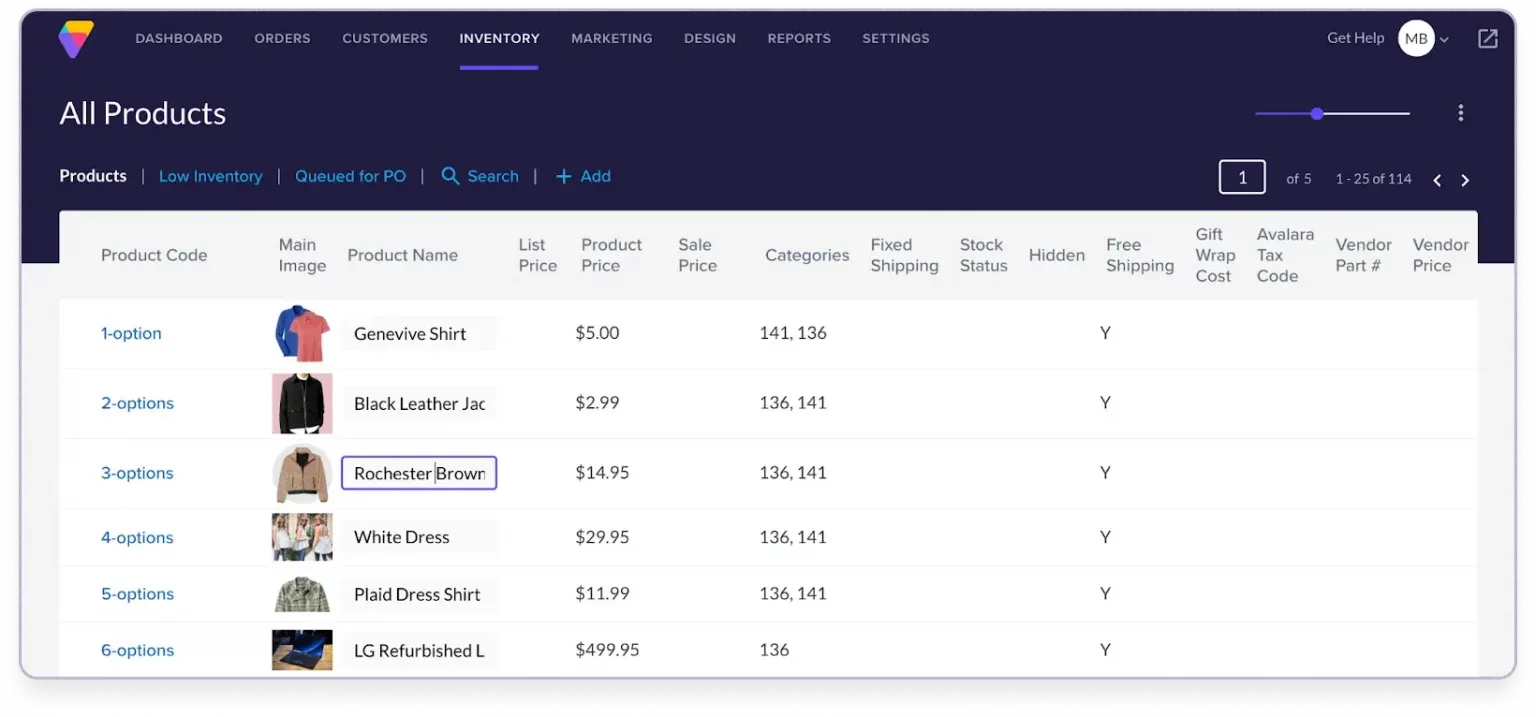
Specifically, stock levels update automatically whenever an order is placed to minimize the risk of overselling and ensure records stay accurate. Plus, the platform also helps merchants stay proactive with restocking. However, when adjustments are necessary (e.g., after processing returns or removing damaged goods), you still need to update quantities manually.
How about businesses with more complex setups? In that case, Volusion does offer multi-location inventory management, though only on higher-tier plans. As the name suggests, this feature lets merchants track stock across more than one warehouse or physical store; nevertheless, keep in mind that it's still far more limited than what larger, multi-channel businesses often need.
WooCommerce's inventory management
WooCommerce, on the other hand, provides a straightforward yet still fairly comprehensive framework.
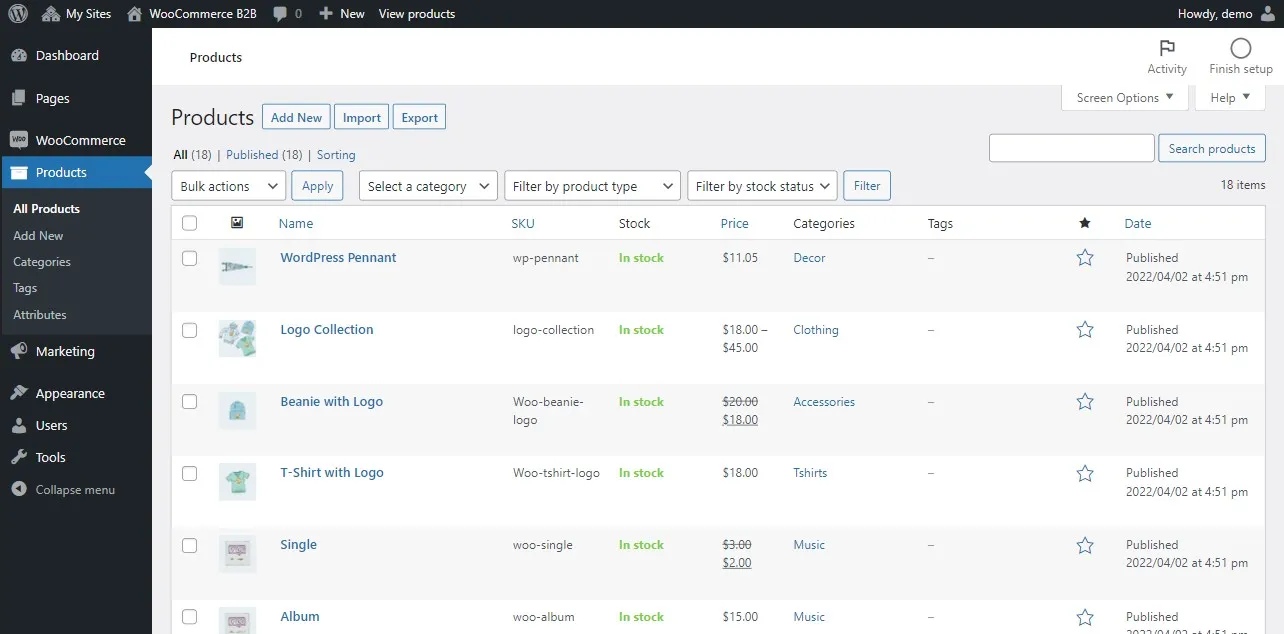
The platform supports diverse product types (including simple, grouped, variable, and affiliate products), so merchants can design catalogs that reflect different kinds of stock and sales behaviors. Setting up variations such as size or color is not much of an issue, and the categories and tags keep everything organized even as inventories grow more complex.
At the same time, WooCommerce also pays attention to product listings via notable features like custom fields and a built-in customer review system. Plus, when it comes to direct stock control, the platform provides both low-stock notifications and manual adjustments at the product level so your team can manage day-to-day inventory without additional tools.
And the best part? The real difference between Volusion vs WooCommerce will show up as your business begins to scale. Unlike with Volusion, WooCommerce can still address advanced needs (e.g., forecasting demand or automating fulfillment) through its extensive plugin marketplace, which we will revisit in the latter half of our article.
Payment Processing (WooCommerce wins)
The Verdict: WooCommerce offers both convenient integrations and a native solution –WooPayments – which is more comprehensive and available in far more countries than Volusion Payments.
Hence, between Volusion vs WooCommerce, WooCommerce is not only more flexible but also more practical for businesses with international goals. To see why the gap is so clear, keep scrolling!
Volusion’s payment processing
So far, Volusion provides merchants with access to over 30 different gateways, including major players like PayPal, Stripe, and Square. Though this number is rather modest, we still consider it reasonably sufficient for most small and mid-sized businesses regarding everyday transactions.
And in addition to these third-party options, Volusion also offers its own branded solution, Volusion Payments. With this option, merchants can consolidate financial data and reporting directly within the Volusion dashboard to keep track of sales and settlements. Plus, it also supports modern features like digital wallet payments (such as Apple Pay) and integrates with “Buy Now, Pay Later” providers.
Nevertheless, at the moment, Volusion Payments is only available to merchants in the United States, which instantly narrows its appeal to international sellers.
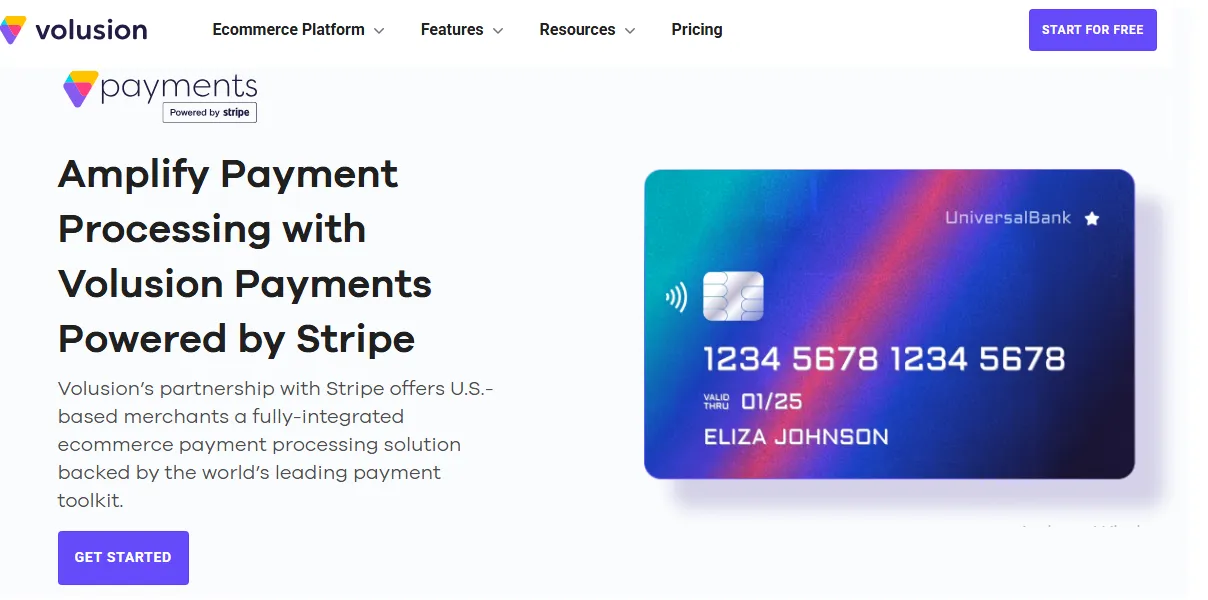
Also, keep in mind that though the solution is marketed as a native system, it is essentially powered by Stripe in the background. That means Volusion isn’t offering an entirely new payment infrastructure, but rather a streamlined version of what Stripe already provides.
WooCommerce’s payment processing
WooCommerce, on the other hand, starts from a much broader foundation. Its marketplace includes more than 80 dedicated payment extensions, so your team can freely tailor checkout experiences to match different markets and customer preferences!
Where WooCommerce really shines, however, is with WooPayments, which is developed by Automattic and deeply integrated into the WooCommerce environment.
With WooPayments, merchants can accept major credit and debit cards as well as digital wallets like Apple Pay and Google Pay directly from their dashboard, without relying on extra add-ons. Also, all of the reporting, reconciliation, and management are stored within WooCommerce itself, which creates a frictionless process that reduces complexity and speeds up the checkout experience.

What gives WooPayments an even stronger edge is its international availability. Unlike Volusion Payments (which is restricted to U.S. merchants, as mentioned earlier), WooPayments is expanding across 35+ countries – a very practical choice for businesses that operate globally or plan to expand into new markets. Combined with the flexibility of WooCommerce’s broader ecosystem, this solution further ensures that businesses aren’t boxed in by geography or limited functionality.
Shipping (Volusion wins)
The Verdict: Between Volusion vs WooCommerce, Volusion's native shipping system is more complete and versatile, so merchants are given a wide variety of options without having to rely on external add-ons. WooCommerce, by design, keeps its core lightweight and depends heavily on its plugin ecosystem for advanced functionality.
We will walk you through how each platform handles shipping in more detail:
Volusion's shipping
Volusion comes equipped with a broad range of native shipping features. Indeed, right in the dashboard, you can choose from six major categories:
- Free shipping can be tied to specific products, order values, weight thresholds, or locations, and it can display qualification messages to encourage larger purchases.
- Live rates pull real-time data from major carriers like USPS, FedEx, UPS, Royal Mail, Canada Post, and Australia Post. That means you can offer customers precise shipping costs at checkout, while still choosing which specific services to enable.
- Flat rate shipping lets you apply fixed costs at the order level, and you can build tiered structures based on order value, weight, or region.
- With Special rates, you can assign fixed fees to individual products, disable shipping entirely for downloadable goods, or configure in-store pickup for local customers.
- Tiered and custom variations give you the flexibility to combine different methods for layered strategies and fine-tune delivery costs.
- Restricted shipping methods provide granular control by limiting which customers can access certain options.
Altogether, Volusion's approach to shipping feels integrated, comprehensive, and ready to use from day one.
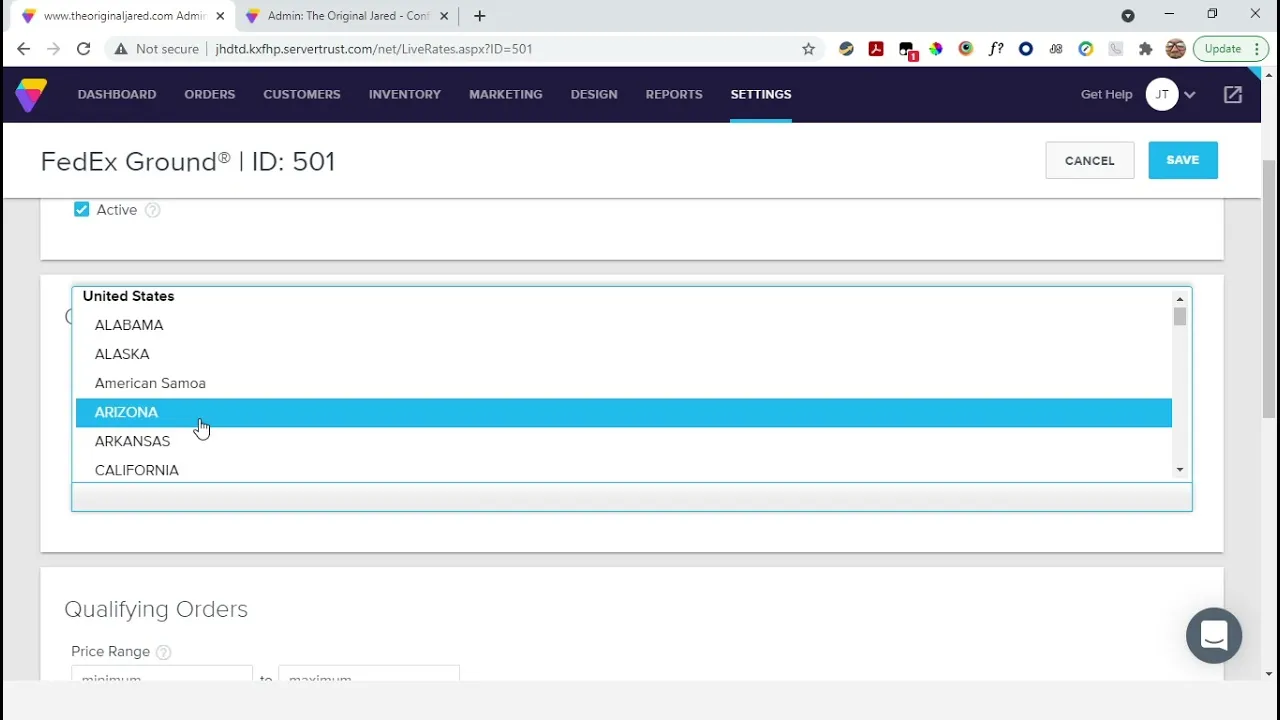
WooCommerce's shipping
By contrast, the available methods in WooCommerce are fairly limited out of the box, as they consist primarily of three main categories: USPS Shipping Method, the Canada Post Shipping Method, and standard Flat Rate services (if you enable them in settings).
To complement this, WooCommerce Shipping offers two packaging choices: either define your own custom boxes and envelopes or use carrier-supplied packaging from USPS, DHL, or UPS. As you can see, these tools cover the basics, but they don't provide the same variety or depth that Volusion delivers natively.
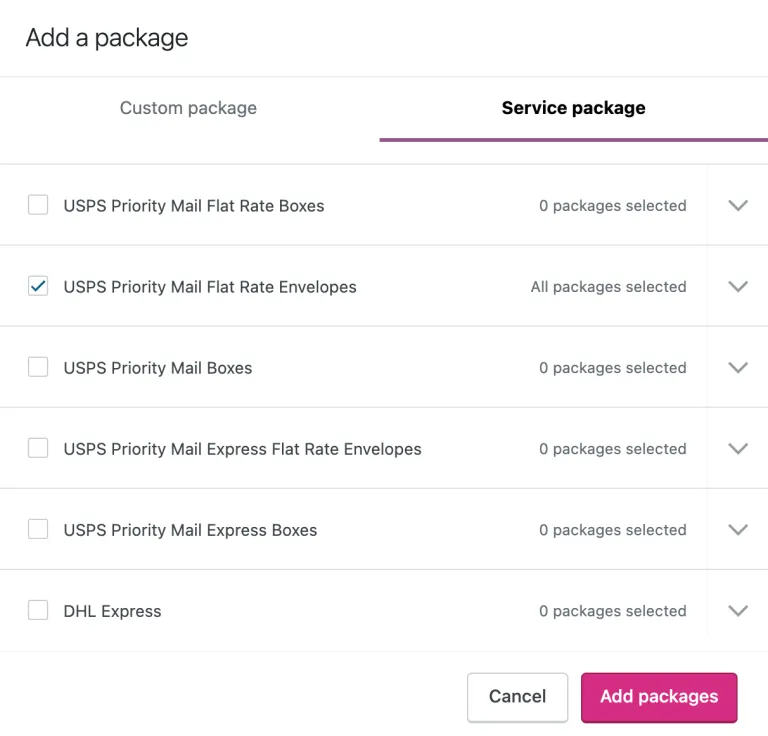
On the other hand, WooCommerce's nature has always been about extensibility. Since the platform's plugin marketplace offers dozens of shipping extensions, you can replicate and even surpass what Volusion offers using the right combination! But, of course, for merchants who want robust options immediately without hunting down and maintaining extra extensions, WooCommerce can feel a bit barebones.
Extensions & Plugins (WooCommerce wins)
The Verdict: WooCommerce wins by a landslide in this Volusion vs WooCommerce comparison. Its extension library is not only vastly larger but also far more polished. Volusion's marketplace, while functional in parts, feels limited and in some cases even outdated.
Let's compare the two ecosystems more closely so you can see why WooCommerce stands out.
Volusion's extensions
Volusion's marketplace is relatively small, with just over 80 solutions available.
And even within that number, the split isn't especially convenient: only about half are direct integrations that store owners can activate themselves. The rest are categorized as services, which means you need to reach out to the provider's team to get them up and running. This extra back-and-forth creates friction and makes the process less straightforward than merchants might expect.
Exploring the marketplace can also feel restrictive, as he only filters available are Category and Type (Integration or Service), which makes narrowing down results clunky. To make matters worse, some of the listings aren't maintained consistently. A few integrations haven't been updated for some time, and in some instances, links to documentation or installation guides even lead to 404 errors.

So all in all, though the marketplace does offer useful options, the overall impression is one of a shallow ecosystem with uneven upkeep.
WooCommerce's extensions
WooCommerce, meanwhile, offers breadth and depth that far surpasses Volusion.
Its official marketplace features more than 1,100 extensions, many of which are built either directly by WooCommerce or by long-standing, trusted development partners. We are also impressed by its remarkably comprehensive range, covering everything from customer relationship management and automated marketing to subscriptions, bookings, shipping solutions, and advanced tax tools.
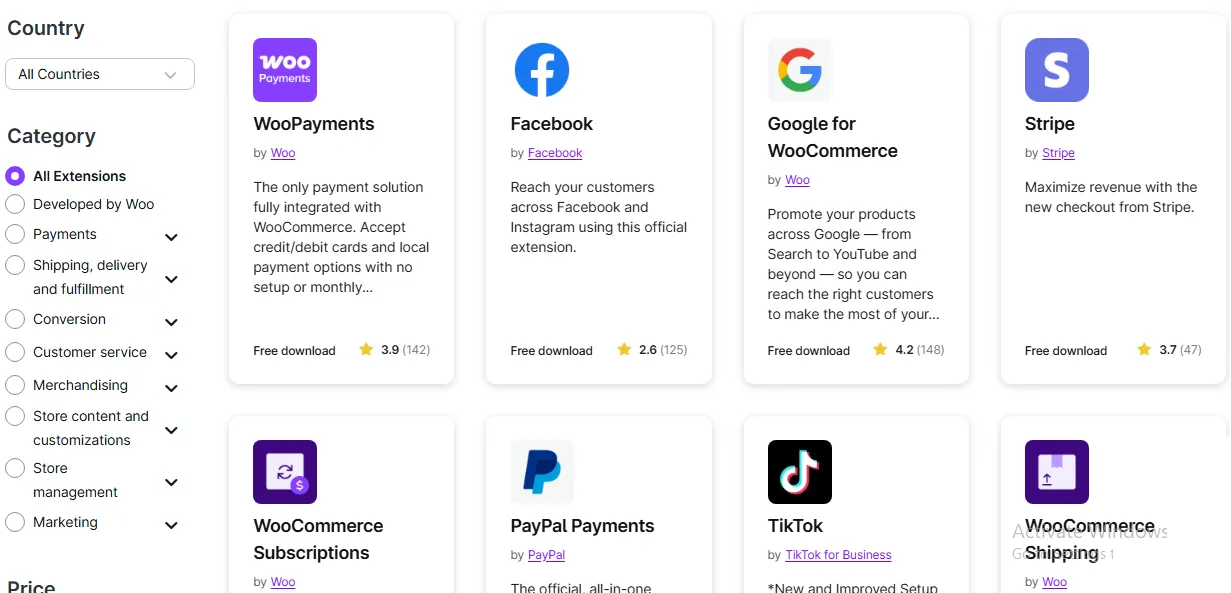
Finding and narrowing your options is also a smoother experience; WooCommerce's marketplace allows you to filter your search by:
- Country (ensuring compatibility with regional requirements)
- Category (to quickly narrow down what type of functionality you need)
- Price (to compare free and premium options).
And don't forget that beyond these extensions, WooCommerce merchants can also draw from the vast WordPress plugin repository, which contains over 60,000 plugins! Sure, compatibility checks are still necessary, but this ecosystem dramatically increases the scope of what can be added to your store.
Scalability (WooCommerce wins)
The Verdict: Between Volusion vs WooCommerce, WooCommerce’s open-source nature and complete control over infrastructure give it far more room to expand. Volusion, as a hosted service, takes care of scaling for you to a point, but eventually its closed environment and limited flexibility become bottlenecks.
That distinction between Volusion vs WooCommerce becomes clearer when you look back at how each platform handles infrastructure and customization:
Volusion’s scalability
From our observation, Volusion performs well for small to mid-sized merchants.
As the infrastructure is already managed for you, you don’t have to worry about servers, bandwidth, or keeping the platform running smoothly under normal traffic spikes. However, the trade-off is that you don’t get access to deeper controls that would allow you to optimize or push the system further. If your store grows to enterprise-level complexity, you’ll quickly run into barriers.
The limitations show up in several ways. First, as mentioned earlier, you can’t fine-tune the hosting environment or implement advanced caching and database optimizations the way you could with an open system. Secondly, Volusion’s restricted ecosystem of integrations and extensions (only 80+ solutions) means that combining specialized search tools with layered caching or automation can be difficult or even impossible.
In short, though Volusion scales reliably within the boundaries it sets, it doesn’t provide the freedom to break through those ceilings when your business demands more.
WooCommerce’s scalability
By contrast, WooCommerce offers virtually unlimited scalability (if you’re willing to manage it, of course).
Since it runs on WordPress and is fully open-source, you can choose the hosting infrastructure that fits your growth strategy, whether that means starting on a modest shared server or scaling up to powerful cloud hosting with horizontal and vertical scaling. Every part of the stack can be fine-tuned, so you can design your store to handle heavy traffic and massive product catalogs without sacrificing performance.
Plus, as discussed, WooCommerce’s ecosystem provides the flexibility needed to keep pace with expansion. With over 1,100 official extensions and access to more than 60,000 WordPress plugins, you have an enormous toolbox for scaling efficiently! This level of freedom ensures that WooCommerce can adapt not just to where your business is today, but to where it’s headed in the future.
SEO & Marketing Tools (WooCommerce wins)
The Verdict: Both Volusion vs WooCommerce provide only basic SEO and marketing tools out of the box. Still, WooCommerce has a much clearer advantage thanks to its plugin ecosystem. With more than 200 marketing extensions available (and even more SEO plugins from the broader WordPress library), it's far easier to build a strategy that goes beyond the basics.
Volusion, in contrast, offers limited options for both customization and extensions, leaving merchants with fewer ways to grow visibility and connect with their audience. This Volusion vs WooCommerce difference becomes especially clear once you look more closely at what each platform offers in practice.
Volusion's SEO & marketing tools
Overall, Vlusion comes with a rather small set of built-in SEO features.
Specifically, merchants can add meta titles, descriptions, and keywords to optimize their product and category pages. Also, those with coding knowledge can tweak meta tags through HTML for more control.
Sure, these tools are enough to get your store indexed by search engines, but they don't go much further. Worse, unlike other platforms, Volusion doesn't provide features like automatic sitemaps, structured data, or advanced on-page optimization, so you might find it challenging to fine-tune a good SEO strategy.
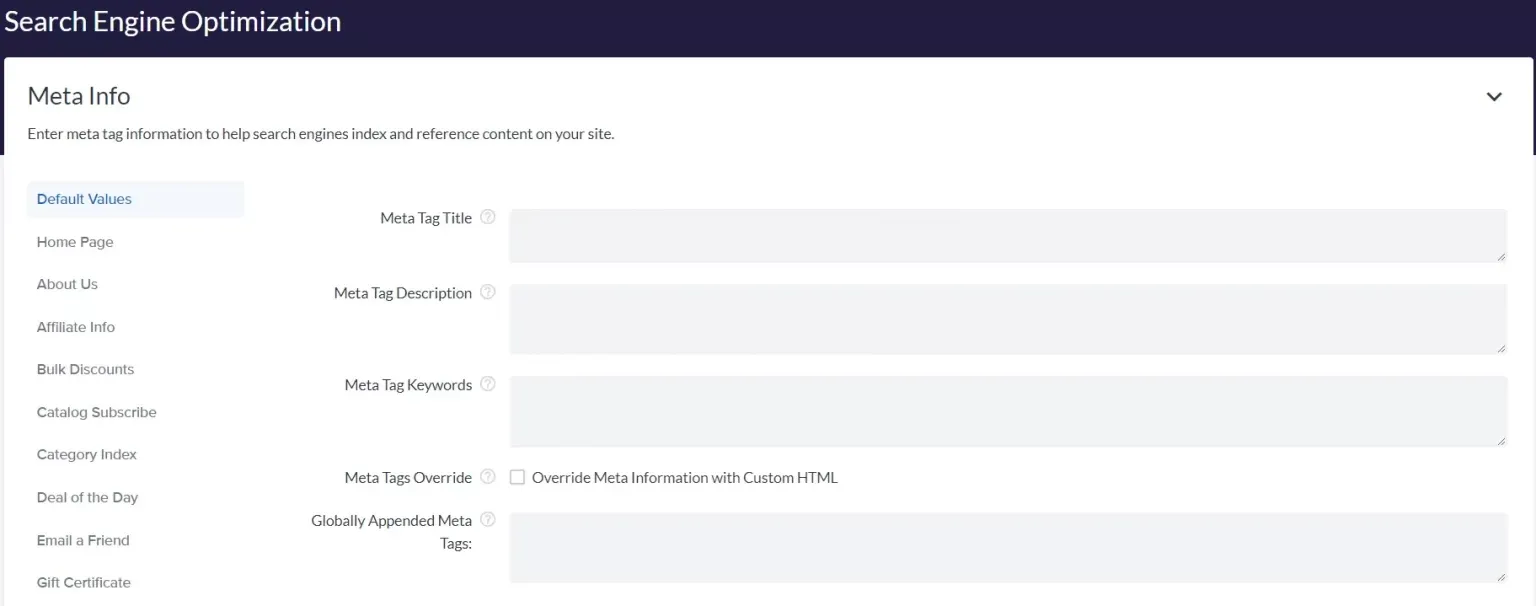
The same pattern shows up in its marketing toolkit. Volusion makes it easy to set up discounts, promotions, and simple email campaigns, which is great for smaller stores just starting out. However, as you can see, these features clearly don't scale well for businesses that want sophisticated automation and advanced targeting.
And that's not all; perhaps the biggest drawback is the absence of a native blogging feature. Content marketing is one of the most effective ways to strengthen SEO and build customer trust, after all; hence, without an integrated blog, merchants on Volusion will lose a vital piece of the puzzle unless they rely on external platforms.
WooCommerce's SEO & marketing tools
Regarding native settings, WooCommerce lets merchants configure SEO basics like permalinks and meta details, giving a solid starting point.
Still, the real power comes from its compatible plugins (like Yoast SEO or Rank Math), which introduce advanced features such as schema markup, keyword tracking, XML sitemaps, and in-depth optimization reports. Plus, since WooCommerce is open-source, merchants have the freedom to layer custom tools into their stores without restrictions.
On the marketing side, WooCommerce also starts with essentials like discount codes, transactional emails, and reporting. Sure, these basic settings can cover day-to-day tasks, but most merchants choose to enhance them with extensions.

The great news: WooCommerce marketplace alone offers around 200 marketing-focused extensions covering everything from email automation and abandoned cart recovery to loyalty programs and CRM integrations. And don't forget that the broader WordPress ecosystem opens the door to thousands more marketing plugins; taken together, it's clear why WooCommerce comes out on top in this criterion.
To make sure you’re using these tools effectively, following a practical SEO checklist can help you avoid missed steps and setup gaps.
Customer Support (Volusion wins)
The Verdict: Volusion may not deliver a flawless support system, but it does give merchants a mix of self-service resources and direct contact options. WooCommerce, by contrast, largely leaves users to rely on documentation and community discussions.
To understand why Volusion takes the edge here, let's look at how Volusion vs WooCommerce structure their support experience.
Volusion's customer support
Regarding customer support, Volusion's Help Center is available around the clock and is filled with articles, FAQs, and tutorials that cover everything from store setup to troubleshooting common issues. For many merchants, this library is a quick and effective way to find solutions without waiting for a response.
And if self-service isn't enough for you, Volusion backs it up with live chat support, also available 24/7 right from the Merchant Center dashboard. Email support is another option, and even phone support is included (though only for Business and Prime plan holders and limited to weekdays).
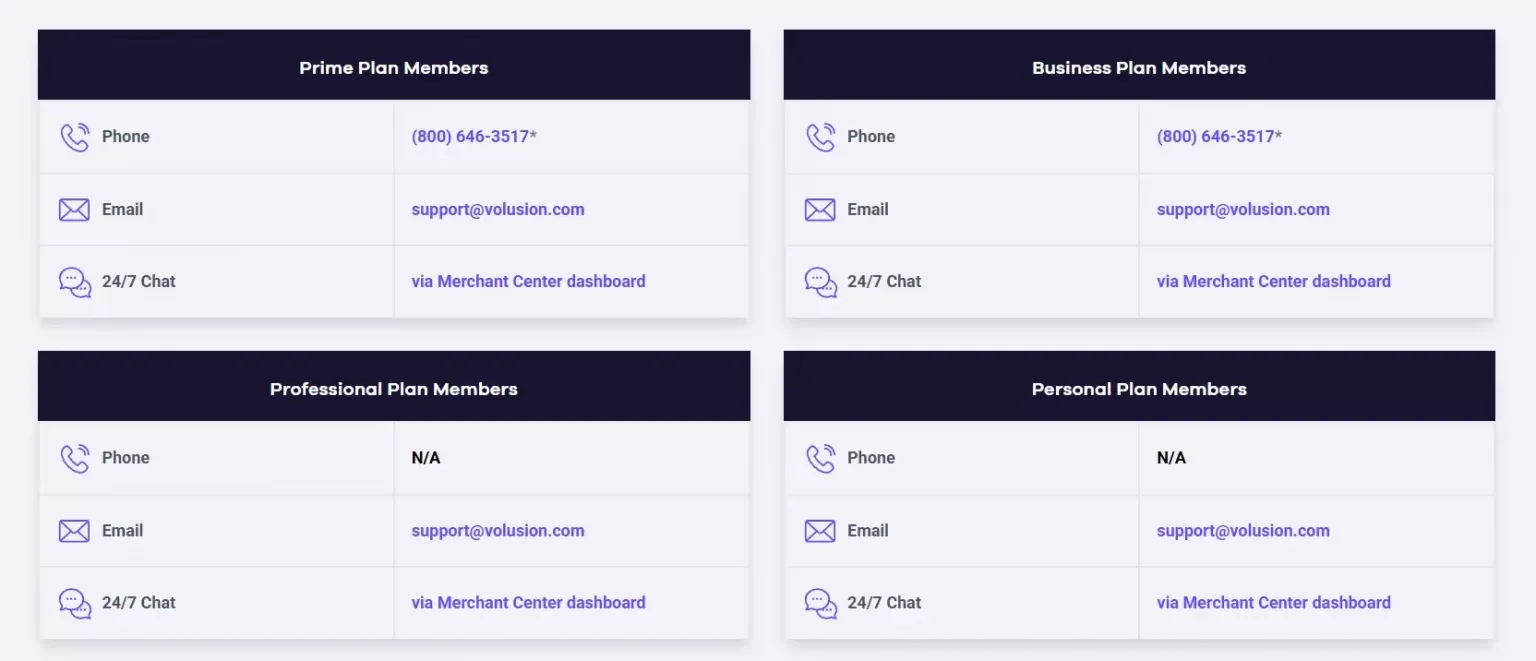
The main shortfall, however, is the absence of a user forum or dedicated community space. From our observation, most other platforms often create environments where users can exchange tips, troubleshoot collaboratively, or share best practices. Volusion, for inexplicable reasons, surprisingly lacks this peer-to-peer layer at the moment.
WooCommerce's customer support
How about WooCommerce?
Its official documentation is extensive, offering resources that range from beginner-friendly guides to advanced developer notes. Plus, unlike with Volusion, merchants on WooCommerce can actually tap into a huge network of forums, Facebook groups, and third-party communities where WooCommerce users actively share advice and solutions.
Unfortunately, where WooCommerce stumbles is in direct, personalized support. Unless you've purchased a premium extension through WooCommerce.com (which grants access to ticket-based assistance), you won't have a direct line to the WooCommerce team. For most users, the primary support channels remain self-service and community interaction.
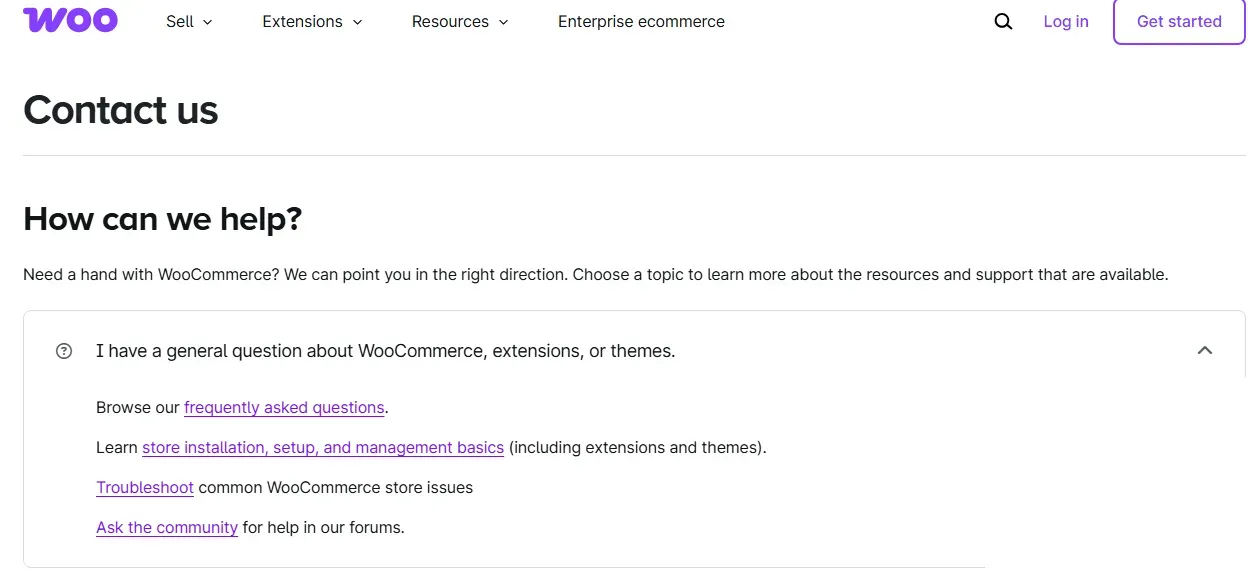
The one exception is that new merchants can still request a consultation to get matched with a WooCommerce expert during the initial setup phase. Still, keep in mind that this help won't extend into ongoing operations.
Security (Volusion wins)
The Verdict: Given Volusion's fully hosted nature, the platform assumes responsibility for protecting both your store and customer data. By contrast, WooCommerce shifts much of the responsibility onto the store owner, despite being backed by a large community and strong technical foundations.
With that in mind, let's take a closer look at Volusion vs WooCommerce security.
Volusion's security
In terms of security, Volusion is PCI DSS Level 1 compliant (the highest standard for handling payment data) and ensures safe processing of every transaction. It also employs AES-256 encryption to safeguard sensitive information and TLS v1.2 to protect data as it moves between your store and customers. Better yet, every store includes a 256-bit SSL certificate by default, so checkout pages are secure right out of the box.
And that's not all. Volusion also runs a web application firewall (WAF) to filter out malicious traffic and an intrusion prevention system (IPS) to stop suspicious activity before it can cause harm. Furthermore, all updates to the core platform happen automatically; merchants don't have to keep track of patches or worry about compatibility.
WooCommerce's security
From our observation, both WooCommerce and WordPress receive frequent updates, which often include important security patches and bug fixes. Plus, given that many developers are monitoring the ecosystem, vulnerabilities are usually identified and addressed quickly, keeping the platform resilient against evolving threats.
On the other hand, the flexibility of open source comes with added responsibility. Since many security breaches stem from outdated or poorly maintained third-party plugins, the overall attack surface is wider compared to a hosted solution like Volusion.
Simply put, store owners must apply updates not just to WooCommerce itself, but also to the WordPress core, their active theme, and every plugin installed. For small shops, this may be manageable with regular attention, but as your store grows over time, patching and compatibility testing can become extremely overwhelming.
Pricing (Volusion wins)
The Verdict: WooCommerce might appear more affordable at first glance (since the plugin itself is free). However, the reality is that Volusion's straightforward plans often work out to be more predictable and, in many cases, more cost-effective once you factor in all the extras needed.
The difference becomes clearer when you compare Volusion vs WooCommerce pricing structures:
Volusion's pricing
At the moment, Volusion offers four main plans that scale according to business size and needs:
- Personal: $35 per month (100 products)
- Professional: $79 per month (5,000 products)
- Business: $299 per month (Unlimited products)
- Prime: Custom
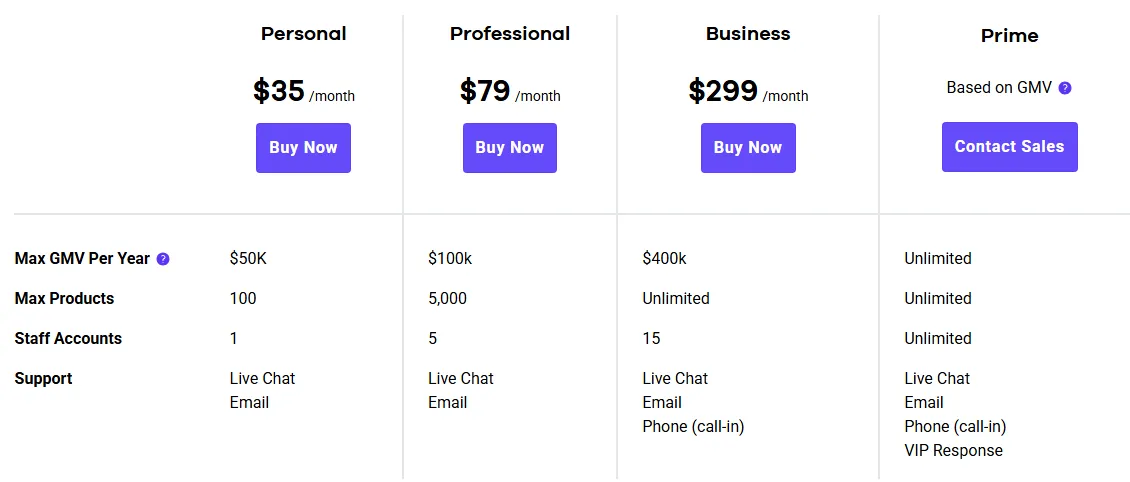
Like with most hosted platforms, each Volusion plan includes hosting, security, and core eCommerce functionality without hidden add-ons, so merchants know precisely what they're paying for.
WooCommerce's pricing
WooCommerce, by contrast, is 100% free to install as a WordPress plugin.
At first, this can give the impression that it's the cheaper option. But once you dig deeper, the costs start to add up quickly. The core plugin provides only the basics (as seen in our previous discussions), so you will likely have to purchase multiple extensions to create a store that feels complete. Just four or five essential add-ons can easily run between $20 and $50 per month, which already surpasses the cost of Volusion's entry-level plans!
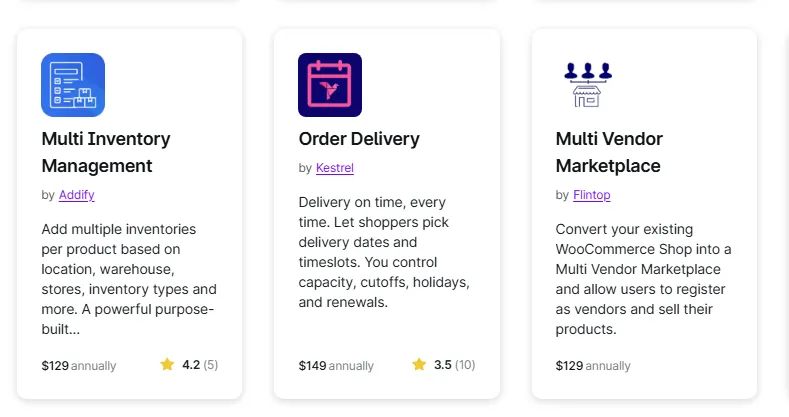
On top of that, don't forget that WooCommerce store owners are responsible for their own hosting, SSL certificates, and performance optimizations. Managed hosting that's powerful enough to support a growing store can add significantly to monthly expenses.
Volusion vs WooCommerce: FAQs
What are the downsides of WooCommerce?
The biggest downside of WooCommerce is that it requires more responsibility from the merchant. You’re in charge of hosting, updates, and security, which can be overwhelming for non-technical users. Costs also creep up quickly, as most advanced features require premium extensions.
Is WooCommerce still relevant?
Absolutely. WooCommerce remains the most widely used eCommerce solution in the world, backed by Automattic (the company behind WordPress.com). Its vast ecosystem of plugins, themes, and global developer support ensures it continues to evolve and meet the demands of modern online stores.
What is the difference between Magento and Volusion?
Magento (now Adobe Commerce) is an open-source, enterprise-grade solution built for highly complex, large-scale businesses. Volusion, on the other hand, is a hosted SaaS platform that caters primarily to small and medium-sized businesses, focusing on bundled features.
When to Choose Volusion vs WooCommerce
Though WooCommerce is a definitely more powerful solution, the choice between Volusion vs WooCommerce still comes down to your business size and resources.
So, choose Volusion if:
- You’re a small to mid-sized merchant who values simplicity and convenience.
- You want to launch quickly without worrying about hosting, SSL, or security setups.
- Your catalog is relatively simple and doesn’t require complex product variations.
- You prefer predictable monthly costs with bundled features rather than piecing together add-ons.
- You don’t plan on heavy international expansion or advanced customizations right away.
And choose WooCommerce if:
- You’re a growing or ambitious business aiming for long-term scalability.
- You want maximum flexibility and control over design, functionality, and hosting.
- You plan to optimize SEO and marketing using blogging, plugins, and advanced tools.
- You sell to international audiences and need diverse payment gateways and localization options.
- You already use WordPress or have access to technical expertise (in-house or outsourced developers).

